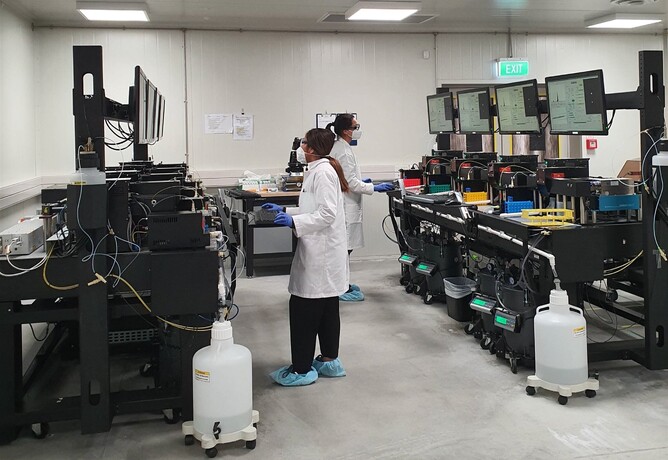CRV has collaborated with Genus IntelliGen® Technologies to bring proven innovative sexed semen technology to New Zealand, giving dairy farmers access to high quality sexed semen to accelerate the genetic gains of their herd.
CRV today officially opened its new sexed semen processing facility at its Bellevue production and logistics facility in the Waikato. It is equipped with IntelliGen® Technology, the only commercial laser-ablation¹ semen sexing technology available in key global markets. This cutting-edge technology has successfully inseminated millions of cattle around the world.
CRV Managing Director James Smallwood says IntelliGen Technology’s process for developing sexed bovine genetics is gentler on the sperm cells than traditional sexed semen processes.
“This cutting-edge technology does not subject semen cells to the high pressures, electric currents and shear forces that are used in the traditional sexed semen technology, which reduces stress on the cells as they are processed.
“The innovative technology we’ll be using at Bellevue means we can provide farmers with a high-quality sexed product to help them maximise their profitability and achieve genetic gains faster and in a more efficient way.”
The new facility will enable CRV to meet the growing demand from New Zealand farmers and overseas markets for its sexed semen, which has tripled since last season.
The rise in demand is a result of dairy farmers looking to accelerate their herds’ genetic gain and reduce bobby calf numbers, which is an increasingly important factor as they consider animal welfare.
Smallwood says dairy farmers need tailored genetic solutions to unlock the potential of their farm business and maximise profitability.
“We call it ‘precision breeding’. This approach means we are helping farmers select the right mix of sexed semen, conventional semen and dairy beef sires to breed better replacements, higher value dairy beef calves and reduce the number of bobby calves.
“We’ve seen demand for sexed straws continue to grow year on year. For herds with good fertility management, using sexed semen from the very best bulls on your best cows is the most effective and fastest way to get ahead.”
Sexed semen is available from a selection of CRV’s best New Zealand and imported bulls, including the company’s stars, such as Scotch, Koromiko and Nucleus. The bulls available are the company’s highest indexing bulls, recognising that farmers want quality replacements from their best cows.
“If farmers make the decision to use sexed semen, they're actually committing to those genetics being in the herd for eight years, because they are unlikely to get a bobby calf. The resulting heifer calves will be the future of their herd. So, it makes sense to spend time selecting the right genetics.
“One of the benefits of our frozen sexed semen is that farmers get exactly the sire they order and can manage their mating allocation on the day.”
CRV’s new facility is EU certified which, for the first time, will allow the company to increase exports to the growing grass-fed genetics market in Europe with sexed semen.
“Fulfilling demand for sexed semen from New Zealand farmers will always be our priority,” says Smallwood. “But the opportunity to export our genetics will help grow our business. That means we can keep investing in solving what matters for farmers by helping them breed healthier more efficient cows.”
¹How does the technology work?
- The semen is put through a preliminary quality control process to make sure it is viable and motile.
- The cells are then stained and loaded onto the technology platform where we identify the sex skew in the sample.
- A sperm cell containing female DNA is heavier and more dense than male DNA. When cells are passing by detection laser, the software can then detect the difference in DNA content.
- The system will then identify the female cells that we’re interested in and use another laser to inactivate the unwanted cells. The desired cells and the inactivated cells are combined and included in the straw. Cells are prepared with the right buffers for freezing and packaged at the right concentration.
- The straws are then frozen. Each batch must pass stringent quality control criteria and is then ready for transport to customers on farm.
Learn more about the process by watching this video from IntelliGen Technologies.

